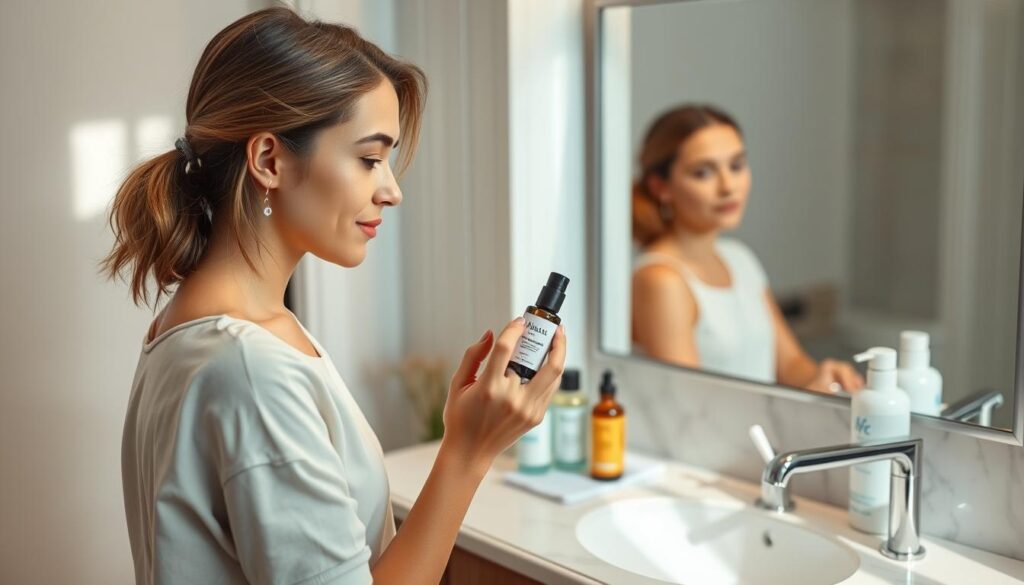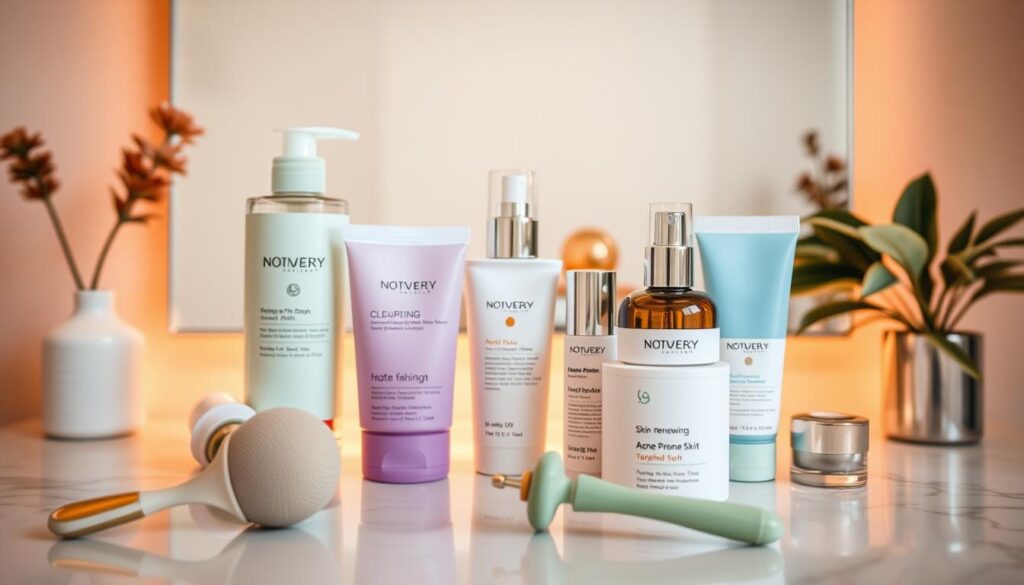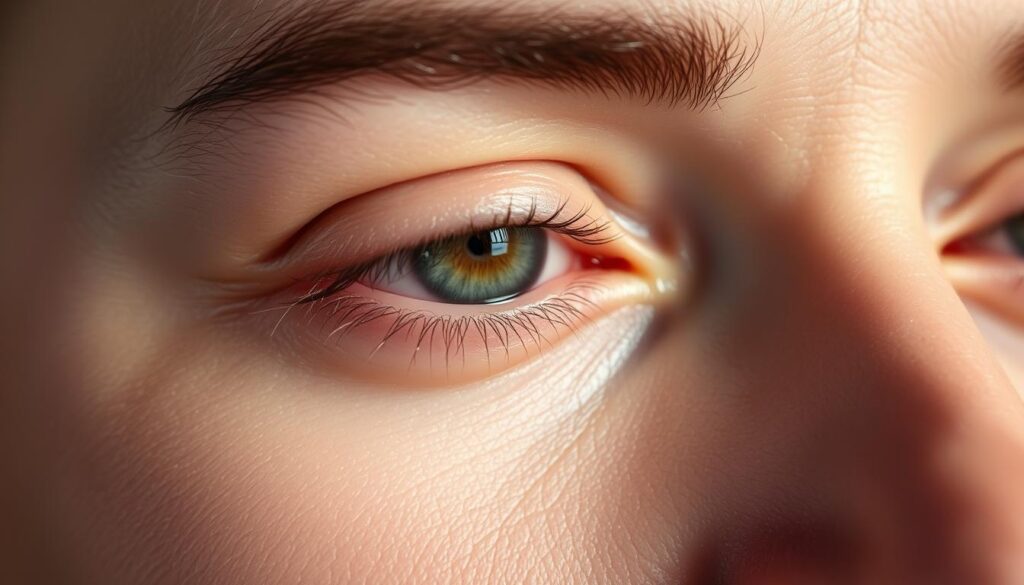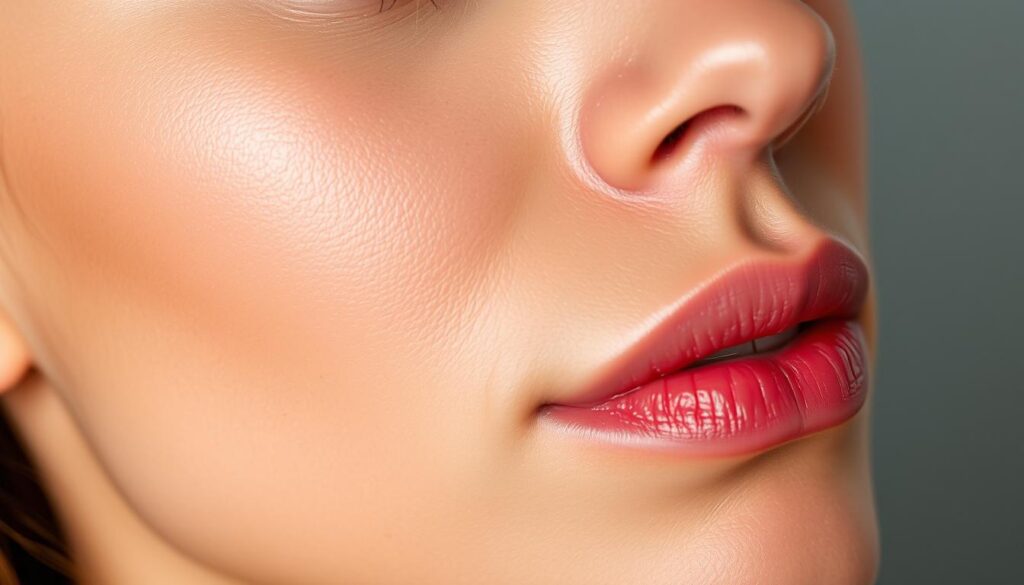Dealing with acne can feel overwhelming, but a consistent and thoughtful approach can make a big difference. Whether you’re managing occasional breakouts or persistent blemishes, understanding your skin’s needs is the first step. Acne affects up to 50 million Americans annually, making it the most common skin condition in the United States1.
A balanced daily care plan is essential. Cleansing your face twice a day helps remove impurities and excess oil, while targeted treatments like salicylic acid or benzoyl peroxide can reduce inflammation and unclog pores1. Consistency is key—dermatologists recommend sticking to a regimen for at least 8 to 12 weeks to see results1.
Protecting your skin is just as important. Sunscreen is a must, especially if you’re using treatments that increase sun sensitivity2. By combining these steps, you can improve both acne and overall skin health. Let’s dive deeper into how to create a plan that works for you.
Understanding Acne-Prone Skin and Its Challenges
Acne-prone skin requires a unique approach to care, as it reacts differently to products and environmental factors. This skin type is often characterized by excess oil production, clogged pores, and frequent breakouts. Understanding these challenges is the first step toward managing it effectively.
What Makes Acne-Prone Skin Unique?
Acne-prone skin is more sensitive to hormonal changes, which can trigger increased oil production. This excess oil, combined with dead skin cells, often leads to clogged pores and breakouts. Unlike other skin types, it may react negatively to certain ingredients, making product selection crucial3.
Bacteria also play a significant role. When pores are clogged, they create an environment where bacteria thrive, leading to inflammation and redness. This is why using noncomedogenic products—those that don’t clog pores—is essential for managing acne-prone skin4.
Common Symptoms and Concerns
If you have acne-prone skin, you’re likely familiar with blackheads, whiteheads, and occasional cysts. These symptoms occur when pores become blocked with oil and debris. Breakouts can be persistent, especially if your routine isn’t tailored to your skin’s needs.
Another common concern is sensitivity. Many people with acne-prone skin report irritation after using harsh products. This is why dermatologists recommend gentle cleansers and treatments that balance oil production without stripping the skin3.
By understanding these challenges, you can take the right steps to care for your skin. Choosing the right products and maintaining a consistent routine are key to keeping breakouts under control.
What Causes Acne?
Acne is more than just a surface-level issue—it’s rooted in complex biological processes. Hormones, excess oil, and bacteria all play a role in creating those frustrating breakouts. Understanding these factors can help you take control of your skin’s health.
Hormonal Fluctuations and Oil Production
Hormones are a major driver of acne. Changes during puberty, menstrual cycles, or even stress can increase oil production in your skin. This excess oil, also known as sebum, can clog pores and create the perfect environment for breakouts2.
Stress hormones like cortisol can also trigger your skin to produce more oil. This is why breakouts often appear during stressful times. Managing stress and maintaining a balanced routine can help keep oil production in check2.
Clogged Pores and Bacterial Growth
When oil and dead skin cells mix, they can block your pores. These clogged pores, or comedones, are the starting point for acne. If bacteria, like P. acnes, get trapped inside, they can cause inflammation and redness5.
Ingredients like benzoyl peroxide and salicylic acid are effective in treating these issues. Benzoyl peroxide kills bacteria, while salicylic acid helps unclog pores by dissolving oil and dead skin cells5.
By targeting both oil production and bacteria, you can address the root causes of acne. Consistency is key—stick to your routine to see lasting results.
The Importance of a Consistent Skincare Regimen
A steady regimen is the foundation for managing acne effectively. When you stick to a plan, your skin has the chance to adapt and improve over time. Consistency isn’t just about using the right products—it’s about giving your skin the care it needs every day.
One of the biggest benefits of a consistent routine is cumulative results. Many treatments, like salicylic acid or benzoyl peroxide, take several weeks to show noticeable improvements6. Skipping steps or switching products too often can disrupt this process, making it harder to see progress.
Balancing active treatments with proper hydration is also crucial. Ingredients like hyaluronic acid and non-comedogenic moisturizers help maintain your skin’s barrier, preventing dryness that can worsen acne7. This balance ensures your skin stays healthy while addressing breakouts.
Long-Term Benefits of Consistency
Following each step systematically supports overall skin health. Cleansing, treating, and protecting your skin daily prevents long-term damage and reduces the risk of scarring8. Experts agree that a structured approach is key to both prevention and treatment.
Consistency also helps your skin adapt to active ingredients. Over time, your skin becomes more resilient, and breakouts become less frequent. This is why dermatologists recommend sticking to a plan for at least 8 to 12 weeks before evaluating results6.
By committing to a steady routine, you’re not just treating acne—you’re building healthier skin for the future. Every step you take today contributes to clearer, more radiant skin tomorrow.
Morning Skincare Routine: Cleanse, Treat, and Protect
Starting your day with the right steps can set the tone for clearer, healthier skin. A well-structured morning routine helps manage oil production, reduce breakouts, and protect your skin from environmental damage. Let’s break it down into three essential steps: cleanse, treat, and protect.
Choosing a Gentle Cleanser
Begin your day with a gentle cleanser that removes impurities without stripping your skin’s natural moisture. Harsh products can disrupt your skin’s barrier, leading to increased oil production and irritation. Look for formulas with salicylic acid or benzoyl peroxide, which help unclog pores and reduce bacteria9.
For example, CeraVe’s Acne Foaming Cream Cleanser contains 4% benzoyl peroxide, making it effective yet gentle for daily use10. Cleansing in the morning prepares your skin to absorb treatments and products more effectively.
Incorporating Acne Treatments Early
After cleansing, apply your acne treatment to target breakouts and prevent new ones. Ingredients like salicylic acid (0.5% to 2%) and benzoyl peroxide (2.5% to 10%) are dermatologist-recommended for their effectiveness9. These active ingredients work by reducing inflammation and unclogging pores.
Consistency is key—use your treatment daily for 4 to 12 weeks to see visible results9. If you’re new to these products, start with a lower concentration to minimize irritation.
Moisturizing and Sunscreen for Daily Protection
Hydration is essential, even for oily skin. A noncomedogenic moisturizer helps balance oil production without clogging pores. Follow up with sunscreen (SPF 30 or higher) to protect your skin from UV damage, which can worsen acne and lead to scarring9.
Products like CeraVe’s AM Facial Moisturizing Lotion combine hydration with SPF 30, making it a convenient choice for your morning routine10. Layering these steps ensures your skin stays healthy and protected throughout the day.
Evening Skincare Routine: Deep Cleanse and Repair
Your nighttime routine is your skin’s chance to recover and repair while you sleep. This is when your skin works hardest to heal itself, making it the perfect time to use targeted treatments and gentle care. A structured evening plan can help reduce breakouts, unclog pores, and promote healthy cell turnover.
Double-Cleansing Techniques
Double-cleansing is a game-changer for removing makeup, sunscreen, and impurities. Start with an oil-based cleanser to break down stubborn products, followed by a water-based cleanser to deep clean your pores. Studies show this method removes up to 99% of impurities, making it ideal for acne-prone skin11.
Choose a cleanser with a neutral pH to avoid irritation. This ensures your skin’s barrier stays intact while effectively removing buildup12. Consistency is key—make this step a nightly habit for clearer, healthier skin.
Nighttime Active Ingredients
After cleansing, it’s time to apply active ingredients that work while you sleep. Retinoids are a top choice for promoting cell turnover and reducing acne lesions. Research shows they can lead to a 50% reduction in breakouts after 12 weeks of nightly use11.
Pair retinoids with lightweight gels or creams to hydrate without clogging pores. Look for formulas with hyaluronic acid or niacinamide to soothe and repair your skin. These ingredients improve hydration and reduce inflammation, helping your skin heal faster11.
For stubborn clogged pores, consider a gentle exfoliant with salicylic acid. It helps remove dead skin cells and unclogs pores, preventing future breakouts. Just remember to exfoliate no more than twice a week to avoid irritation11.
By focusing on deep cleansing and repair, your evening routine can transform your skin’s health. Stick to these steps, and you’ll wake up to a clearer, more radiant complexion.
Best Skincare Routine for Acne-Prone Skin
Acne management isn’t one-size-fits-all—it’s about personalizing your approach. Your skin’s needs can change over time, so adjusting your routine is key to maintaining clarity and health. Whether you’re dealing with occasional breakouts or persistent blemishes, understanding your skin type is the first step toward effective care13.

Tailoring Your Routine to Your Skin Type
Not all prone skin is the same. Some people produce excess oil, while others struggle with dryness and sensitivity. Identifying your skin’s unique characteristics helps you choose the right products. For example, if you have oily skin, a cleanser with salicylic acid can help unclog pores and reduce breakouts14.
For those with sensitive skin, gentle formulas with hydrating ingredients like hyaluronic acid are ideal. Dermatologists recommend avoiding harsh scrubs, as they can irritate and worsen acne in up to 80% of users14. By tailoring your routine, you can address your skin’s specific needs without causing further damage.
Balancing Active Ingredients with Hydration
Active ingredients like retinoids and benzoyl peroxide are powerful tools for managing acne. However, they can also dry out your skin if not balanced with proper hydration. Studies show that combining retinol with 2.5% benzoyl peroxide significantly reduces acne lesions after 12 weeks13.
To avoid irritation, pair these treatments with a noncomedogenic moisturizer. Hydrating products can improve skin moisture levels by 40%, even when using drying treatments14. This balance ensures your skin stays healthy while effectively treating breakouts.
| Skin Type | Recommended Ingredients | Hydration Tips |
|---|---|---|
| Oily | Salicylic acid, benzoyl peroxide | Use lightweight, oil-free moisturizers |
| Dry | Hyaluronic acid, ceramides | Layer hydrating serums under creams |
| Sensitive | Niacinamide, aloe vera | Avoid fragrances and harsh exfoliants |
Adjusting your skincare routine over time is also important. As your skin changes, so should your products. For example, if you notice increased dryness, switch to a richer moisturizer. Consistency and adaptability are key to long-term success13.
Selecting the Right Cleansers and Makeup Removers
Effective cleansing is the cornerstone of any successful acne management plan. The products you use on your face can either help or hinder your efforts to keep breakouts at bay. For those with oily skin, choosing the right cleanser is especially important to control excess oil production and prevent clogged pores15.
Importance of Noncomedogenic Formulas
Noncomedogenic products are designed to avoid clogging pores, making them ideal for acne-prone skin. These formulas are gentle yet effective, removing dirt, makeup, and impurities without stripping your skin’s natural moisture16. Look for cleansers labeled as noncomedogenic to ensure they won’t aggravate your acne.
For those with oily skin, gel-based cleansers are a great choice. They help control oil while providing a deep clean. Ingredients like salicylic acid can further unclog pores and reduce breakouts15. If you wear makeup, consider double-cleansing to remove all traces of product and prevent buildup17.
When selecting a product, pay attention to the ingredients. Avoid harsh chemicals that can irritate your skin. Instead, opt for formulas with hydrating ingredients like hyaluronic acid to maintain your skin’s moisture balance16. This approach ensures your face stays clean and healthy without over-drying.
By choosing the right cleansers and makeup removers, you can create a solid foundation for your acne skincare routine. Consistency and the right products are key to achieving clearer, healthier skin.
Key Acne-Fighting Ingredients to Look For
Finding the right ingredients can transform your approach to managing breakouts. Whether you’re dealing with occasional pimples or persistent acne, understanding what works can make all the difference. Let’s dive into the most effective options and how they can help you achieve clearer skin.
Benzoyl Peroxide and Salicylic Acid
Benzoyl peroxide has been a trusted ingredient for over 50 years, making it one of the most popular treatments for acne18. It works by killing bacteria and reducing inflammation, which helps prevent new breakouts. Products can contain up to 10% concentration, the highest strength available without a prescription18.
Salicylic acid, a beta-hydroxy acid, promotes natural exfoliation to unclog pores and reduce blackhead formation18. It’s gentle yet effective, making it a great choice for daily use. Products like CeraVe’s Acne Control Cleanser contain 2% salicylic acid, which is proven to clear acne and improve skin texture18.
Retinoids, Niacinamide, and Other Actives
Retinoids, derived from vitamin A, are powerful tools for promoting cell turnover and reducing post-acne marks18. They also help minimize pore appearance and improve overall skin texture. Start with a lower concentration to avoid irritation, and always use sunscreen during the day19.
Niacinamide, a form of vitamin B3, soothes the skin and strengthens its protective barrier. It’s particularly helpful for reducing redness and balancing oil production18. Pair it with hydrating ingredients like hyaluronic acid to maintain moisture levels.
When using these actives, consistency is key. Give your skin at least four weeks to adjust, and consult a dermatologist if you experience severe irritation19. By choosing the right ingredients, you can take control of your skin’s health and achieve lasting results.
Tailoring Treatments to Your Skin’s Needs
Choosing between spot treatments and full-face applications depends on your acne’s severity and distribution. Understanding when to use each method can help you achieve clearer, healthier skin. Let’s explore how to evaluate your needs and adjust your approach accordingly.
When to Use Spot Treatments
Spot treatments are ideal for targeting individual breakouts. They contain concentrated ingredients like benzoyl peroxide or salicylic acid, which reduce inflammation and unclog pores20. Use these products when you have isolated pimples or small clusters of acne. Studies show that salicylic acid can reduce acne lesions by up to 60% when applied consistently21.
Apply the treatment directly to the affected area, avoiding healthy skin to prevent irritation. This method is especially effective for mild to moderate acne, as it minimizes exposure to active ingredients22.
When Full-Face Applications Are Better
For widespread acne, a full-face approach is often more effective. Products like retinoids or lightweight gels can address multiple areas simultaneously. This method is particularly useful for those with oily skin or frequent breakouts20.
Full-face treatments also help prevent new breakouts by maintaining consistent application across your skin. For example, using a noncomedogenic moisturizer can reduce the risk of clogged pores by 50%21.
Common Mistakes to Avoid
One of the most frequent errors is overusing spot treatments. Applying too much can dry out your skin and cause irritation. Another mistake is skipping sunscreen when using retinoids, which can increase sun sensitivity22.
Always follow the instructions on your product label. If you’re unsure, consult a dermatologist to ensure you’re using the right acne treatment for your skin type20.
| Treatment Type | Best For | Tips |
|---|---|---|
| Spot Treatment | Isolated breakouts | Apply sparingly to avoid irritation |
| Full-Face Application | Widespread acne | Use lightweight, noncomedogenic formulas |
By tailoring your approach, you can maximize the benefits of your acne treatment while minimizing irritation. Consistency and proper application are key to achieving lasting results.
Incorporating Sunscreen and Moisturizers Effectively
Protecting your skin from UV damage and maintaining hydration are essential steps in managing acne effectively. Dermatologists stress that proper sun protection and moisture retention are crucial for keeping your skin barrier healthy and preventing breakouts23.
Choosing Oil-Free and Lightweight Options
When selecting a moisturizer, opt for oil-free and lightweight formulas. These products hydrate your face without clogging pores, which is vital for acne-prone skin. Look for ingredients like hyaluronic acid, which can hold up to 1,000 times its weight in water, providing deep hydration23.
For sunscreen, choose a broad-spectrum formula with SPF 30 or higher. This protects against 80% of UV rays, even on cloudy days23. Gel-based sunscreens are ideal for oily skin, as they absorb quickly and leave no residue.
The Role of Sunscreen in Acne Prevention
UV rays can worsen acne and lead to scarring, making sunscreen a must in your daily routine. Studies show that daily use can reduce the risk of melanoma by 50% and prevent 90% of skin cancer cases24. Always apply it as the final step in your morning routine, even on cloudy days.
Balancing Hydration and Acne Treatment
Hydration is key to maintaining your skin barrier, but it’s important to avoid heavy creams. Noncomedogenic moisturizers with ceramides and fatty acids reinforce your barrier without causing breakouts23. Pair these with your acne treatments to keep your skin balanced and healthy.
| Product Type | Key Features | Application Tips |
|---|---|---|
| Oil-Free Moisturizer | Lightweight, noncomedogenic | Apply after cleansing and treatments |
| Broad-Spectrum Sunscreen | SPF 30+, gel or lotion | Use daily, even indoors |
By incorporating these steps, you can protect your face from UV damage and maintain hydration without aggravating acne. Consistency and the right products are key to achieving clearer, healthier skin.
Avoiding Common Skincare Mistakes for Acne-Prone Skin
Managing acne effectively often comes down to avoiding common pitfalls that can worsen your skin’s condition. Over-cleansing, over-exfoliating, and using too many active ingredients at once are some of the most frequent mistakes. These habits can lead to increased inflammation and clogged pores, making acne worse25.
Over-cleansing strips your skin of its natural oils, causing it to produce even more oil to compensate. This can lead to more breakouts. Instead, stick to cleansing twice a day with a gentle product. Over-exfoliating, on the other hand, can irritate your skin and damage its barrier. Limit exfoliation to 1-2 times a week to avoid irritation26.
Using too many active ingredients, like peroxide or retinoids, can also backfire. Experts recommend introducing one new treatment at a time to see how your skin reacts. This approach helps you identify what works without overwhelming your skin27.
Another mistake is skipping hydration. Even oily skin needs moisture to maintain its barrier. Look for lightweight, noncomedogenic moisturizers that won’t clog pores. Proper hydration can reduce inflammation and prevent dryness, which can trigger more breakouts25.
Finally, avoid picking at your skin or using harsh scrubs. These actions can damage your skin and lead to scarring. Instead, use a targeted spot treatment for individual breakouts. By avoiding these common mistakes, you can create a healthier, more effective acne care routine26.
Expert Tips and Dermatologist Recommendations
Expert advice can transform your approach to managing acne effectively. Dermatologists like Dr. Lolis and Dr. Zeichner emphasize the importance of balancing active ingredients with hydration. This ensures your skin stays healthy while addressing breakouts28.
Advice from Leading Dermatologists
Dr. Gohara recommends using a salicylic acid cleanser twice daily to minimize blackheads and whiteheads. For oily skin, stronger formulations can target deeper concerns like hyperpigmentation28. Dr. Zeichner suggests pairing retinoids with sunscreen to prevent acne scars and improve skin texture29.
Spot treatments with benzoyl peroxide are effective for developed pimples, while salicylic acid works best for early-stage breakouts. Avoid using retinoids and benzoyl peroxide together to prevent irritation28.
Adjusting Your Routine Over Time
As your skin adapts, it’s important to modify your routine. Start with one new ingredient at a time to monitor your skin’s reaction. Gradually increase the frequency of exfoliation if needed, but limit it to 2-3 times a week29.
If you notice increased dryness, switch to a richer moisturizer. Consistency is key—stick to your plan for at least 3-4 months to see results29. Consulting a dermatologist can help you refine your approach and overcome plateaus.
By listening to your skin and making gradual changes, you can achieve clearer, healthier skin. Expert-backed steps ensure your acne treatment is both effective and sustainable.
Conclusion
Achieving clearer skin is possible with the right steps and a bit of patience. A consistent routine tailored to your needs can make a significant difference. Start with gentle cleansing twice daily to remove impurities and prevent breakouts30. Incorporate targeted treatments like salicylic acid or benzoyl peroxide to reduce inflammation and unclog pores31.
Don’t forget sun protection. Using a broad-spectrum sunscreen with SPF 30 or higher shields your face from UV damage, which can worsen acne and lead to scarring32. Pair this with a lightweight, noncomedogenic moisturizer to maintain hydration without clogging pores30.
Consistency is key. Stick to your skincare routine for at least 6-12 weeks to see noticeable improvements31. Adjust your approach as needed, and consult a dermatologist for personalized advice. With dedication and the right care, you can achieve healthier, clearer skin.



